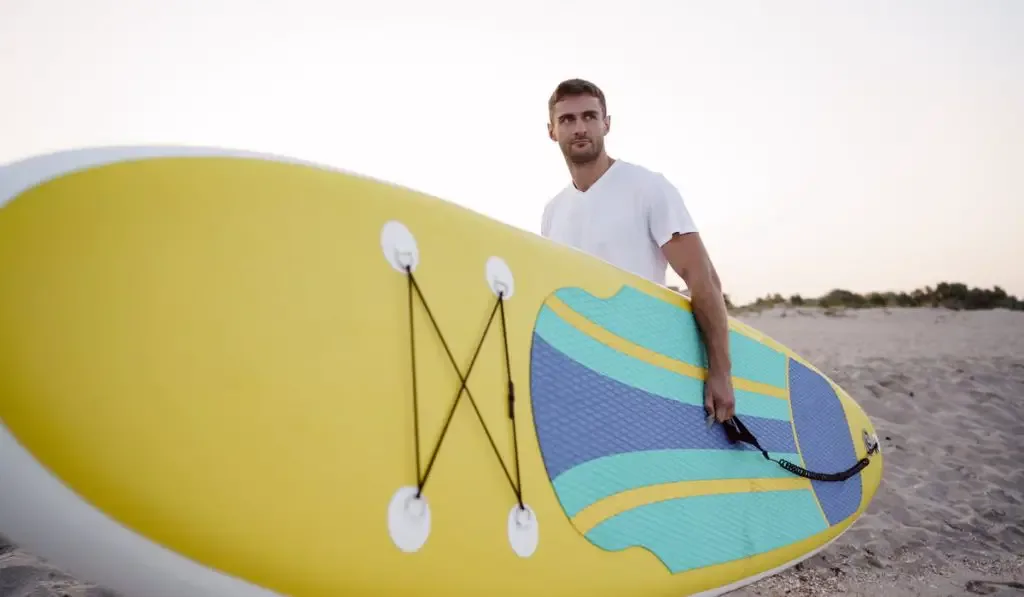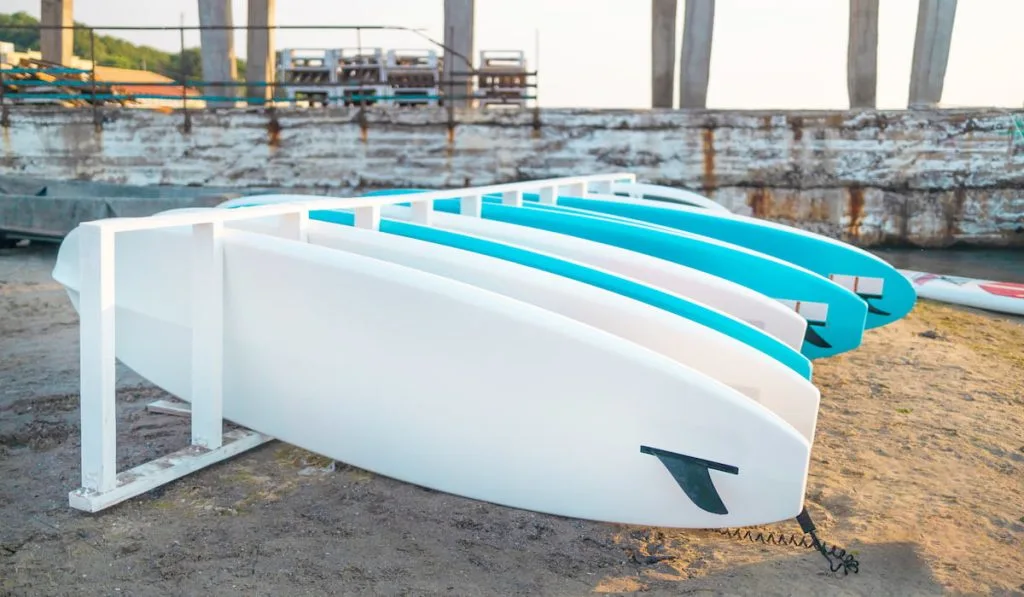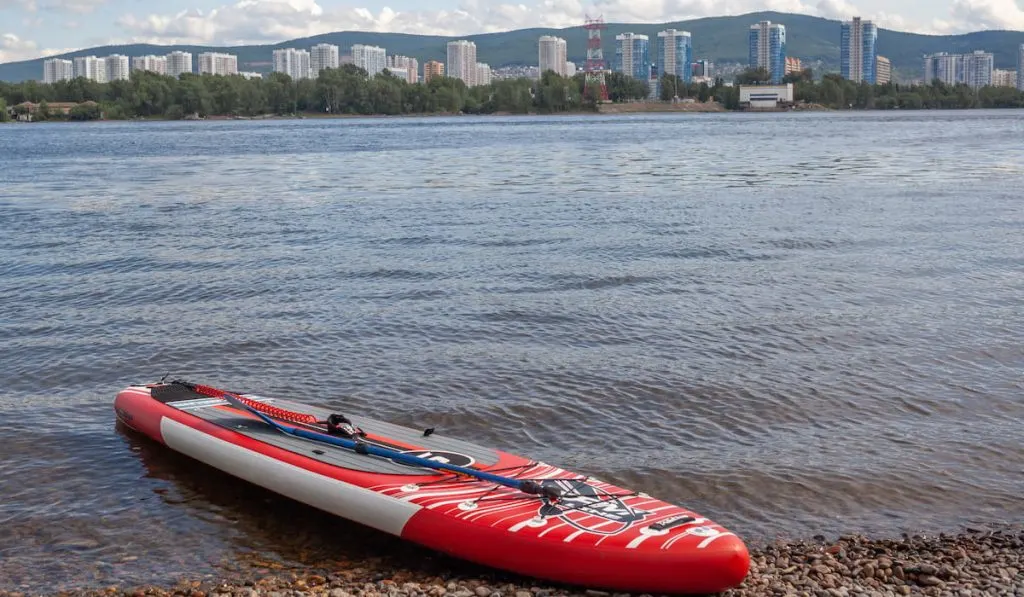Surfboards and paddleboards share a few similarities. So, if you are new to stand-up paddling, there is a chance that you’ve considered using your old surfboard as a paddleboard. But should you do this? Let us find out.
Can I use a surfboard as a paddleboard?
You might be able to use a surfboard as a paddleboard but doing so is not ideal.
Surfboards do not offer sufficient volume, stability, and floatation to play the role of paddleboards.
So, in many cases, one is better off getting an actual paddleboard.
In this article, we dig deep into the world of surfboards and paddleboards. We talk about using surfboards as paddleboards, the differences between both types of boards, and much more.
Can I Use a Surfboard as a Paddleboard?
You can use a surfboard as a paddleboard if you have superior balancing skills and are pretty lightweight. Skilled riders who ride very fast might also be able to use a surfboard as a paddleboard.
The speed promotes buoyancy and makes up for the relatively lower floatation offered by surfboards. But even at that, paddling on a surfboard is not the best way to go.
The physical properties of surfboards and paddleboards are markedly different. These distinctions make them unsuitable as substitutes for each other.
For one, paddleboards are markedly longer, thicker, and broader than surfboards. These dimensional differences make them more stable than surfboards.
Besides stability, paddleboards are built to endure prolonged periods of standing. On the other hand, with surfboards, you are, most of the time, laying prone. Of course, this disparity means that surfboards may not support the same weight as paddleboards.
The explanation above does not tell the whole story. So, below we discuss some other reasons why surfboards are not ideal for use as paddleboards:
Foam Volume
The floatation of paddleboards and surfboards is dependent on their foam volumes. The higher the foam volume, the stronger the floatation.
Since they have to endure the localized weight of a standing paddler for long periods, paddleboards need more floatation than surfboards. For this reason, paddleboards typically come with foam volumes over 3.5 cu. feet (100 liters). Surfboards, on the other hand, usually have only around .85 to 1.13 cu. feet (24 to 32 liters) of foam.
Going by the above, surfboards can only offer a third or a fourth of the floatation paddleboards offer. Of course, this is not optimal for safety.
With an average foam volume of 3 cu. feet (85 liters), surfing longboards come close to the floatation of paddleboards. But even their suitability in paddleboarding is limited. They may not be ideal in many cases.

Deck
Paddleboards come with a reinforced deck. The essence of the deck reinforcement is to localize the paddlers’ weight in one area and endure the pressure of their weight on the board.
Unlike paddleboards, surfboards do not have reinforced decks. Surfers lay prone on surfboards mostly, so the pressure of their weight on the board is minimal.
If one uses a surfboard as a paddleboard, the chances of the board collapsing under them are high. This happens because their decks are not sturdy enough to endure the weight of a body standing for long periods.
Rocker
The rocker of paddleboards is relatively flatter and longer than those of surfboards. This makes gliding on them more efficient and reduces the efforts needed for paddling. This is why it is pretty easy to travel in a straight path with them.
Surfboards, on the other hand, have curvier, shorter rockers than paddleboards. So, traveling in a straight line is a bit more complicated with them. This means if you use them as paddleboards, you will have to put more effort into paddling.
Dimension
As we mentioned earlier, paddleboards are thicker than surfboards because of their high foam volume. On average, paddleboards are about 4 inches in thickness. Surfboards, in contrast, are typically 2 ¼ to 3 ¼ inches thick.
Paddleboards are typically 14 feet long. Surfboards, in contrast, are usually around 5 to 10 feet long.
Surfboards are around 17 to 22 inches wide, depending on the experience of the surfer. Paddleboards, on the other hand, are about 32 to 34 inches wide.
As you can see, the differences in the dimensions of both types of water boards are pretty substantial. So, they cannot offer the same experience for different purposes.
All in all, since paddleboards are longer, thicker, and broader, they are more stable than surfboards.
Surface
The surface of paddleboards is designed to be textured or gripping. This way, they keep the paddler from slipping or falling off.
Conversely, surfboards have liberally waxed surfaces. This will not be a problem for surfers since they do not spend much time standing on the board. But for paddleboarders, the waxed surface of surfboards increases the chances of sliding.

Can I Use a Paddleboard as a Surfboard?
You can use a paddleboard as a surfboard but doing this is also not ideal.
Since paddleboards float better than surfboards, one can get into waves with them readily. This is pretty helpful for people who may be having a hard time learning to catch and surf bigger-sized waves.
On the flip side, paddleboards are not as responsive as surfboards. So, they do not turn as fast as surfboards, and they are generally not as easy to control. In stronger waves, paddleboards pose potential dangers because of the limited maneuverability.
Besides the control issues, paddleboards are broader than surfboards, so hand paddling is not easy for people with small arms.
Is Paddleboarding Harder Than Surfing?
Paddleboarding is not harder than surfing, quite the opposite. The conditions for paddleboarding are not as complicated as those for surfing.
To paddleboard, you need calm, flat water alongside basic reactive and balance skills. Of course, these are not difficult to attain.
Conversely, if you want to surf, you need a higher level of reactive skills. Your balance must also be top-notch, and you must back it all up with heightened coordination. Surfing requires waves, and you do not get that with calm, flat waters. Plus, you must know how to read waves to survive out there.
What Makes a Surfboard Easy to Paddle?
One factor that makes a surfboard easy to paddle is width. The higher the width of a surfboard, the higher its surface area. The higher the surface area and width of a surfboard, the more stable and buoyant it will be.
In surfboards, floatation and stability make for a more trouble-free gliding and paddling.
While the width of a surfboard can make it easier to paddle, excessive width might be an issue when hand paddling. If your surfboard is too broad for your arms, you may not be able to row with your hands.
What Surfboard Is Easiest to Paddle?
Surfing longboards are the easiest type of surfboard to paddle. As you may have guessed, the ease they bring is related to their size.
Longboards have higher foam volume and surface area. For these reasons, they are relatively more stable, and you can surf for longer on them. Besides, you can catch waves earlier with them, even if the waves are small or barely above your ankle.

Can You Surf With an Inflatable SUP?
You can surf with an inflatable SUP. But generally, inflatable SUPs are more suited for light waves, not heavy waves.
As expected, the suitability of inflatable SUPs differs from one product to another. But generally, inflatable SUPs offer a softer landing to surfers; this feature is particularly beneficial to beginners.
Besides offering a soft landing, inflatable SUPs inflict a lighter impact if the board flips over and lands on you.
Furthermore, the soft surface of inflatable SUPs is more comfortable when you surf on your knees.
If you have been surfing on surfboards or regular SUPs, it may take a while for you to get used to surfing on an inflatable SUP. So, just be a little patient when you make the switch.
Is There a Weight Limit for Paddleboarding?
There is no weight limit for paddleboarding. But there are weight limits for paddleboards.
Paddleboards come in various lengths, widths, and thicknesses. These properties decide how much weight they can carry.
On average, paddleboards can carry between 200 and 300 pounds.
But some models are designed to support up to 500 pounds.
When choosing a paddleboard, do not go beyond the weight limit stated by the manufacture. If you do, you run the risk of capsizing the board while riding.
Apart from that, the experience on a board not suitable for your weight is not really enjoyable. Besides, such boards will sail deeper in the water because you are too heavy for them. Consequently, they will be less stable, and you will have a hard time maneuvering, paddling, and balancing them.

Choosing the Right Paddleboard for Your Weight
Manufacturers state the weight limit of their paddleboards in two ways:
- Pounds or Kilograms
- Cubic Liters (volume)
When they state the weight limit in pounds or kilograms, choosing the right paddleboard for your weight is pretty simple. Once you know what you weigh, you know the boards to opt for.
When manufacturers state the weight limit in volume (cubic liters), you may have to do a little math.
To get your weight limit in volume (cubic liters), multiply your weight by 1.4. The value you get is the maximum volume of a board that can accommodate you.
To get the minimum volume of a board that can carry you, multiply your weight by 1.
For example, if you weigh 180 pounds, you should look out for boards with volumes between 180 and 250 cubic liters.
Final Take
You can use a surfboard as a paddleboard. But the experience will not match that of an actual paddleboard.
Paddleboards are more buoyant and more stable than surfboards. They also have higher weight limits. Therefore, they are simpler to paddle and ride. Plus, you can stand on them for long periods, and they will not collapse under you.
Resources
- https://www.ridingboards.com/can-you-use-a-surfboard-as-a-paddleboard/
- https://bestsportslounge.com/surfboard-paddleboard
- https://www.paddleboardnation.com/the-difference-between-stand-up-paddleboard-and-surfboard/
- https://thesurfboardwarehouse.co.nz/blogs/board-advice-blog/board-anatomy
- https://www.surfcanarias.com/surfboard-sizes-which-one-to-choose
- https://www.pumpedupsup.com/blogs/news/what-size-sup-board-is-right-for-you
- https://aquasportsplanet.com/is-paddle-boarding-easier-than-surfing-i-tried-them-both/
- https://barefootsurftravel.com/livemore-magazine/surfboard-dimensions-length-width-thickness-foil
- https://www.everydaycalifornia.com/blogs/everyday-thoughts/surfing-101-types-of-surfboards
- https://isupworld.com/inflatable-paddle-boards-for-surfing/
- https://www.pumpedupsup.com/blogs/news/surfing-sup-buyers-guide
- https://paddlecamp.com/how-much-weight-can-a-paddle-board-hold/
